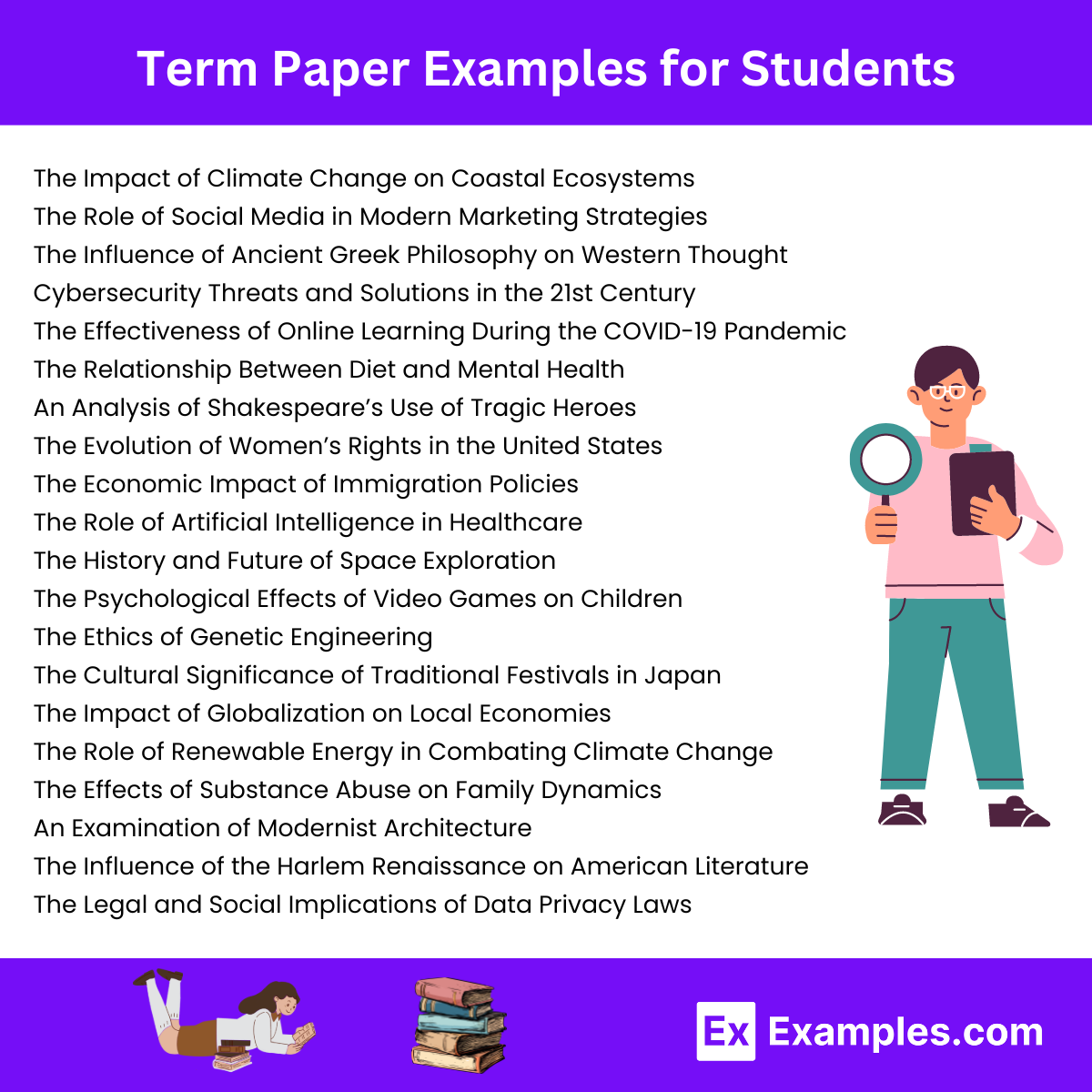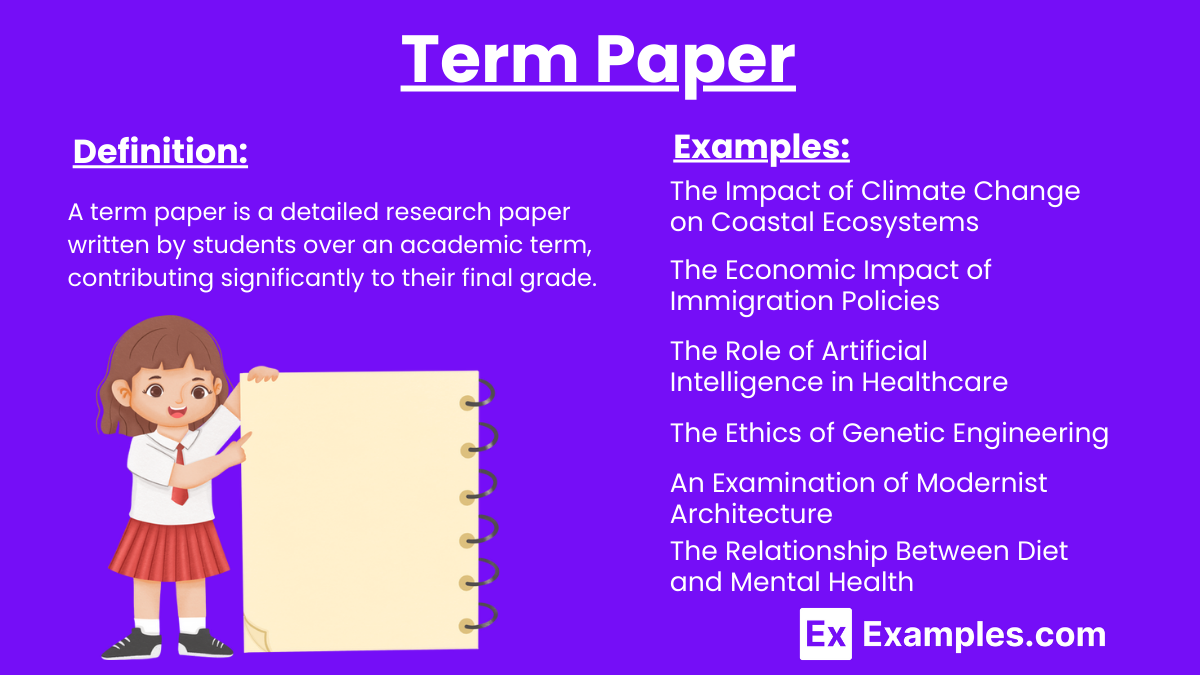30+ Term Paper Examples
A term paper is an extensive research paper typically assigned at the end of a semester or academic term, allowing students to demonstrate their understanding and in-depth knowledge of a particular subject. It involves thorough research, analysis, and synthesis of information from various sources to address a specific topic or question, culminating in a comprehensive written report. Term papers are designed to assess students’ critical thinking, research skills, and ability to communicate their findings effectively, often accounting for a significant portion of their final grade. Essential components include a Thesis Statement for Research Paper, a Research Paper Cover Letter, and adherence to the Research Paper Format.
What is Term Paper?
A term paper is a detailed research paper written by students over an academic term, contributing significantly to their final grade. It demonstrates their understanding and analysis of a specific topic, includes a thesis, supporting arguments, and evidence, and requires citations from academic sources.
Term Paper Format
Title Page
Title of the Paper
Student’s Name
Course Name and Number
Instructor’s Name
Date of Submission
Abstract
- A brief summary of the paper (150-250 words)
- Key points, objectives, methods, results, and conclusions
Introduction
- Introduction to the topic
Thesis statement
Purpose and objectives
Paper overview
Literature Review
- Overview of Existing Research
Key Theories and Studies
Gaps in the Literature
Relevance to the Current Study
Methodology
- Research design
- Data collection methods
- Sample selection
- Analysis techniques
Results
Presentation of findings
Use of tables and figures (if applicable)
Discussion
Interpretation of results
Comparison with existing literature
Implications and limitations
Conclusion
Summary of key findings
Restatement of thesis
Future research implications
References
List of All Sources Cited
Formatted According to a Specific Citation Style (APA, MLA, Chicago, etc.)
Appendices (if applicable)
Additional Material
Raw Data
Questionnaires
Detailed Calculations
Formatting Guidelines
Font: Times New Roman, 12-point
Spacing: Double-spaced
Margins: 1 inch
Page numbers: Top right corner
Consistent headings and subheadings
Term Paper Examples for Students

- The Impact of Climate Change on Coastal Ecosystems
- The Role of Social Media in Modern Marketing Strategies
- The Influence of Ancient Greek Philosophy on Western Thought
- Cybersecurity Threats and Solutions in the 21st Century
- The Effectiveness of Online Learning During the COVID-19 Pandemic
- The Relationship Between Diet and Mental Health
- An Analysis of Shakespeare’s Use of Tragic Heroes
- The Evolution of Women’s Rights in the United States
- The Economic Impact of Immigration Policies
- The Role of Artificial Intelligence in Healthcare
- The History and Future of Space Exploration
- The Psychological Effects of Video Games on Children
- The Ethics of Genetic Engineering
- The Cultural Significance of Traditional Festivals in Japan
- The Impact of Globalization on Local Economies
- The Role of Renewable Energy in Combating Climate Change
- The Effects of Substance Abuse on Family Dynamics
- An Examination of Modernist Architecture
- The Influence of the Harlem Renaissance on American Literature
- The Legal and Social Implications of Data Privacy Laws
- The Role of Sports in Promoting Social Integration
- An Analysis of Economic Inequality in Developing Countries
- The Impact of Music Therapy on Mental Health Recovery
- The Development and Impact of the Internet of Things (IoT)
- The Relationship Between Sleep Patterns and Academic Performance
Simple Term Paper Examples
- The Effects of Video Games on Child Development
- The History and Impact of the Civil Rights Movement
- Genetically Modified Organisms (GMOs): Benefits and Risks
- The Influence of Greek Philosophy on Western Thought
- The Impact of Immigration on the U.S. Economy
- The Role of Education in Reducing Poverty
- The Ethics of Animal Testing in Medical Research
- Mental Health Stigma and Its Social Implications
- The Evolution of E-commerce and Online Shopping
- The Importance of Early Childhood Education
Types of Term Papers
1. Analytical Term Papers
- Definition: Analyzes a specific issue or topic, breaking it down into its components and examining them in detail.
- Purpose: To provide a deep understanding of the subject through detailed analysis.
- Example: “The Economic Impact of Climate Change on Agriculture”
2. Argumentative Term Papers
- Definition: Presents an argument on a particular topic, supporting it with evidence and reasoning.
- Purpose: To persuade the reader of a specific viewpoint or stance.
- Example: “The Case for Renewable Energy Sources over Fossil Fuels”
3. Definition Term Papers
- Definition: Explores the meaning and implications of a specific concept or term.
- Purpose: To clarify and define a concept in depth.
- Example: “Defining Social Justice in Modern Society”
4. Compare and Contrast Term Papers
- Definition: Examines the similarities and differences between two or more subjects.
- Purpose: To highlight comparative aspects and provide insights into the subjects.
- Example: “Comparing Online Education with Traditional Classroom Learning”
5. Cause and Effect Term Papers
- Definition: Investigates the causes of a particular event or phenomenon and its effects.
- Purpose: To understand the relationships between events and outcomes.
- Example: “The Causes and Effects of the 2008 Financial Crisis”
6. Interpretive Term Papers
- Definition: Provides an interpretation of a specific piece of literature, artwork, or historical event.
- Purpose: To offer insights and perspectives on the subject.
- Example: “Interpreting Symbolism in F. Scott Fitzgerald’s ‘The Great Gatsby'”
7. Research-Based Term Papers
- Definition: Relies heavily on existing research and data to discuss a particular topic.
- Purpose: To present an in-depth analysis based on extensive research.
- Example: “The Role of Vaccinations in Public Health”
8. Reflective Term Papers
- Definition: Reflects on a personal experience or event and its significance.
- Purpose: To provide a personal perspective and insights.
- Example: “Reflections on My Internship Experience in a Non-Profit Organization”
9. Case Study Term Papers
- Definition: Focuses on a detailed examination of a particular case within a real-world context.
- Purpose: To analyze specific instances and draw broader conclusions.
- Example: “A Case Study of the Flint Water Crisis”
10. Expository Term Papers
- Definition: Explains or describes a topic in a straightforward and factual manner.
- Purpose: To inform and educate the reader about the subject.
- Example: “An Overview of the U.S. Healthcare System”
Importance of Term Papers
1. Development of Research Skills
- Encourages thorough exploration of various information sources
- Enhances data gathering, analysis, and interpretation abilities
2. Enhancement of Writing Skills
- Improves clarity, precision, and organization in writing
- Refines grammar and syntax
3. Critical Thinking and Analytical Skills
- Fosters logical reasoning and problem-solving
- Promotes evaluation and synthesis of information
4. Time Management and Discipline
- Teaches effective planning and adherence to deadlines
- Develops a disciplined work ethic and organizational skills
5. In-Depth Understanding of Subject Matter
- Facilitates comprehensive knowledge of the topic
- Enhances retention and application of theoretical concepts
How to Write a Term Paper
1. Choose a Topic
- Select a topic: Ensure it’s relevant to your course and interests you.
- Narrow the focus: Make sure the topic is specific enough to be manageable.
2. Conduct Research
- Gather sources: Use books, academic journals, and credible websites.
- Take notes: Organize your notes and highlight key points.
- Create a bibliography: Keep track of all sources for your references.
3. Develop a Thesis Statement
- Clear and concise: Summarize the main point or argument of your paper.
- Position: Clearly state your position or perspective on the topic.
4. Create an Outline
- Introduction: Introduce the topic and state your thesis.
- Body paragraphs: Organize the main points and supporting evidence.
- Conclusion: Summarize your findings and restate your thesis.
5. Write the First Draft
- Introduction:
- Hook: Grab the reader’s attention.
- Background information: Provide context.
- Thesis statement: Present your main argument.
- Body Paragraphs:
- Topic sentence: State the main idea of the paragraph.
- Evidence: Present data, quotes, and research findings.
- Analysis: Explain how the evidence supports your thesis.
- Transition: Link to the next paragraph.
- Conclusion:
- Restate the thesis: Summarize your main argument.
- Summarize main points: Recap the key points.
- Closing statement: Provide a final thought or call to action.
6. Revise and Edit
- Review content: Ensure your arguments are clear and supported by evidence.
- Check organization: Ensure your paper flows logically.
- Edit for grammar and style: Correct any grammatical errors and improve readability.
7. Format the Paper
- Follow guidelines: Use the required formatting style (APA, MLA, Chicago, etc.).
- Title page: Include the title, your name, course, instructor, and date.
- Page numbers: Ensure all pages are numbered.
- Citations: Properly cite all sources in-text and in the bibliography.
8. Proofread
- Final check: Look for any remaining errors or typos.
- Read aloud: Helps catch mistakes you might overlook.
- Peer review: Have someone else review your paper for feedback.
9. Submit the Paper
- Meet the deadline: Ensure you submit your paper on time.
- Follow submission guidelines: Submit according to your instructor’s requirements (e.g., online or printed copy).
FAQ’s
How do I choose a topic for my term paper?
Choose a topic that interests you, is relevant to your course, and has enough research material available.
What is the structure of a term paper?
A term paper typically includes an introduction, literature review, methodology, results, discussion, conclusion, and references.
How long should a term paper be?
The length varies, but a standard term paper is usually between 8-15 pages, depending on the subject and requirements.
How do I start writing a term paper?
Begin with thorough research, create an outline, and then draft your introduction to set the context for your paper.
What is a thesis statement in a term paper?
A thesis statement is a concise summary of the main point or claim of your paper, usually placed at the end of the introduction.
How important is the introduction in a term paper?
The introduction is crucial as it sets the tone, provides background information, and presents your thesis statement.
What should be included in the literature review?
The literature review should summarize, analyze, and compare existing research relevant to your topic.
How do I cite sources in my term paper?
Use a citation style recommended by your instructor (e.g., APA, MLA, Chicago) to credit the original sources of your information.
How do I present my findings in a term paper?
Present your findings clearly and logically, using tables, charts, or graphs if necessary, in the results section.
How do I write a conclusion for a term paper?
Summarize your main points, restate the significance of your findings, and suggest areas for future research.



